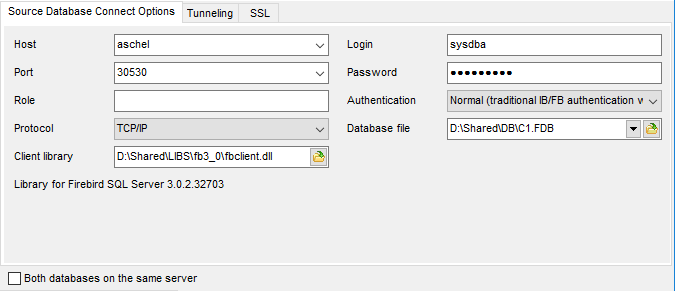Online Documentation for DB Comparer for InterBase/Firebird
Setting database options
Database connection properties for the source and target databases are set in the same way.
If both the source and target databases are located on the same server, you can check the ![]() Both databases on the same server option and set all the properties (except for the database name) only once.
Both databases on the same server option and set all the properties (except for the database name) only once.

Connect options
Enter Interbase/Firebird host name in the Host field and specify the preferable Network protocol (TCP/IP, NetBEUI, Novel SPX, Local, Embedded). The Host drop-down list contains the list of already used hosts. Enter Interbase/Firebird port to connect through in the Port field.
Afterwards you should specify authorization settings: Login and Password.
The default superuser name is 'SYSDBA' and the default password is 'masterkey'.
If necessary, use the drop-down list to specify the preferable Client charset to be used by the application.
You also need to specify the Role (optionally), the path to the Client library and the path to the Database file (*.gdb for InterBase or *.fdb for Firebird) in the corresponding fields. For successful connection to the server it is crucial to use the appropriate client library - the one that is compatible with the server you are using: gds32.dll for InterBase and fbclient.dll for Firebird. Please note that the client library file must be located on your local machine (e.g. in the directory where the utility is installed). Bear in mind that the path to the database file should be set relatively to the Interbase/Firebird server file system.
Click the ![]() button of the Database file field to specify the location of the Interbase/Firebird database file using the standard Open file dialog.
button of the Database file field to specify the location of the Interbase/Firebird database file using the standard Open file dialog.
Authentication type
Select the preferable type of server authentication to be used for the connection:
- Normal (traditional IB/FB authentication with security database)
- Win32 NTLM authentication (only FB 2.1 or above)
- Mixed
Authorized Interbase/Firebird users are stored in a security database. Each Interbase/Firebird server has its own security database, which means that a user definition is bound to the server where it is stored. The security database also stores an encrypted password for each user.
Type in or use the ![]() button to specify the path to the security database. The drop-down list contains the previously specified security databases.
button to specify the path to the security database. The drop-down list contains the previously specified security databases.
If you are using the EMS SQL Management Studio for Interbase/Firebird version of DB Comparer for Interbase/Firebird then the Select registered database button is available. Click this button to pick a database already registered in the EMS SQL Management Studio in the Select Host or Database dialog.
Tunneling
To setup the connection via SSH tunnel, input the following values in the corresponding fields:
- SSH host name is the name of the host where SSH server is running
- SSH port indicates the port where SSH server is activated
- SSH user name stands for the user on the machine where SSH server is running (Note: it is a Linux/Windows user, not a user of Interbase/Firebird server)
- SSH password is the Linux/Windows user password
Note: When the SSH tunneling is set the '*' symbol appears on the tab header.

![]() Use Private Key for authentication
Use Private Key for authentication
Check this option to enable Private Keys usage for the connection.
For details see SSH tunneling options.
SSL
Client certificate
Set the full path to the SSL certificate on the client machine.

Passphrase file
Set the full path to the file containing the key passphrase.
Passphrase
Input passphrase password.
CA file
Specify the name of the certificate authority file.
CA path
Set the path for the location of the certificate authority file.
When done, press the Next button to set compare options.


































































